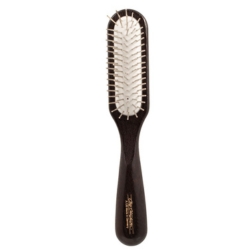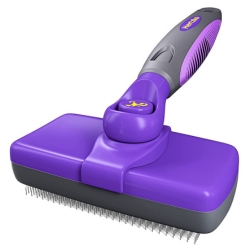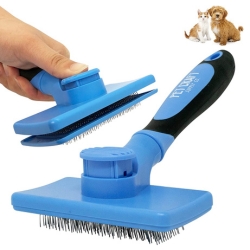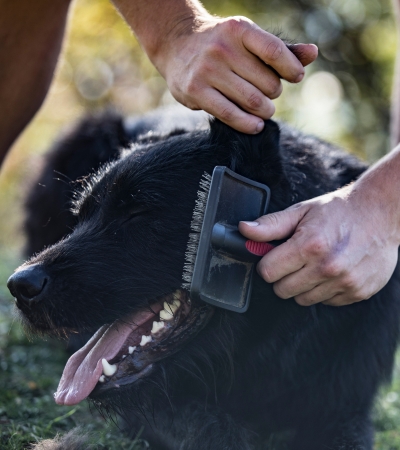The Best Dog Brushes — Buyers Guide, Review, and Comparison
Top Brushes for Dogs Comparison Table
The Best Dog Brushes Buying Guide
Why You Should Use a Dog Grooming Brush
How Often Should I Brush My Dog?
The Best Dog Brush — Our Picks
Best Dog Brushes FAQs
TOP RECOMMENDED BRUSHES FOR DOGS

Original Series T Brush
This Chris Christensen brush is truly a great tool to have in your grooming kit! The T style makes it easier to use by allowing for less pressure on your hands and wrists while you pamper your pooch.
Suited for all coat types, whether your dog has a coarse, drop, smooth, or wire coat, you can be confident this brush is best for your needs. The lightweight beechwood and stainless steel pins are sure to give your pooch a glowing sparkle to their coat!
- Less wrist movement.
- Brilliant for removing dead undercoat.
- Lightweight.
Every dog is different and we don’t just mean their size, shape, and temperament. Looking closer at dogs’ coats, you have plenty of things to consider. Does your pooch have coarse or fine hair? Are they single or double-coated? Do they have luscious curls or straight, silky locks? The answers to these questions can point you in the direction of the correct grooming tools. But, to make things easier, check out our best dog brushes guide.
Image
Product
Details

Handle Material: Beechwood
Brush Style: Slicker / Pin
Coat Type: Undercoat
Size: 16 / 27 mm (pin length)
Air vents for extra cushioning/flexibility.
Two pin lengths available.
Smooth-end pins for comfort and ease of use.
Product Rating: 4.7/5

Handle Material: Rubber
Brush Style: Slicker
Coat Type: All
Size: 27 mm (pin length)
Easy to hold.
Suitable for all coat types.
Sturdy.
Product Rating: 4.7/5

Handle Material: Beechwood
Brush Style Pin
Coat Type: All
Size: 20 mm (pin length)
Gently removes tangles and matting.
Solid beechwood handle.
Great for hard-to-reach places.
Product Rating: 4.7/5

Fusion Oval Brushes
Handle Material: Ash Wood
Brush Style: Pin
Coat Type: Thick coats
Size: 20 / 27 mm (pin length)
Gets through thick fur.
Prevents mats.
Durable.
Product Rating: 4.7/5

Handle Material: Rubber
Brush Style: Slicker
Coat Type: Curly / Thick
Size: 4.1 x 2.49 inches (head size)
Rotational head for easy cleaning.
Great gripping handle.
Works on long and short coats.
Product Rating: 4.6/5

Hertzko Self-Cleaning Slicker Brush for Dogs
Handle Material: Rubber
Brush Style: Slicker
Coat Type: All coat types
Size: Not disclosed
Durable handle.
Removes dirt and reduces shedding.
Easy to clean with retractable bristles.
Product Rating: 4.5/5

Handle Material: Metal
Brush Style: Slicker
Coat Type: All
Size: 4 inches (head size)
Suitable for all pets.
Easy clean button.
Gentle on pets' skin.
Product Rating: 4.4/5

Handle Material: Metal
Brush Style: Slicker / Deshedding
Coat Type: Undercoat
Size: Not disclosed
Detangles legs and body.
Easy push button cleaning.
Keeps loose hair together.
Product Rating: 4.4/5

Handle Material: Plastic
Brush Style: Bristle
Coat Type: All
Size: 7 inches (brush length)
Flexible bristles for greater comfort.
Great for all types of fur.
Comfortable grip.
Product Rating: 4.3/5
Grooming your dog is important, and finding the best dog brushes to get the job done can be tricky. There are so many different types — from slicker brushes for dogs to deshedding brushes — it’s no wonder many pet parents get confused as to which one is best.
You may be asking yourself, do I need a dog brush for short hair? What about a deshedding brush for dogs? The type depends on their breed size and coat type/length. So to make this decision easier for you, we’ve compiled an informative list pointing out the best and not-so-best bits on some leading brands.
What Brush Do I Need?
There are four main dog brush formats — rake, pin, slicker, and bristle. Each one has different objectives when brushing, and they treat your dog’s coat differently from each other.
1. Rake Brush for Dogs
The rake-style brush is best on thicker coats. It’s usually T shaped, and the teeth work well to detangle and remove dead fur you would otherwise find around your home. This type is best used on dogs with double coats, like the German Shepherd.
A great undercoat brush, it’s sure to get stuck into the second layer of your pooch’s coat, helping to remove the dead hair that can trap debris. However, be sure to get the correct pin size for your dog. If they’re too short, the brush won’t be able to penetrate the double coat, and if you choose pins that are too long, you could hurt and damage your dog’s skin.
2. Pin Brush for Dogs
Many dog owners tend to have these brushes rolling around the drawer at home. They’re very similar to a brush you and I would use, typically oval-shaped with widely spaced pin bristles. It’s a common misconception that these are good brushes for a good groom but they rarely get through a thicker coat and generally only remove excess surface fur. That said, these are ideal for a finishing brush after a groom.
One note worthy of a mention, check for rounded pin ends. This will prevent the brush scratching your dog.
3. Slicker
A slicker brush is made up of wires that are close together. Best used on curly cuties, the soft slicker brush can work through your dog’s coat to detangle.
The only thing to be aware of is that using this brush with too much force could be uncomfortable for your pooch if faced with a severe mat. Owners should put the right amount of pressure on this comb to get through the curls, yet not too much to irritate their skin.
4. Bristle
Bristle brushes are the best dog brush for shedding short hair. Breeds like Pugs and Jack Russells benefit from the tight bristles — taking excess fur from their bodies while giving their skin a gentle massage.
Brushing your dog regularly shouldn’t be a mundane routine or painful for your pooch. In fact, it can become a therapeutic part of your dog’s routine. Think of you in the salon, there’s nothing quite like someone massaging your head, right?
The same should be instilled in your best pal. Now, I’m not naive to think that you won’t end up with a wrestle at times, but brushing your dog is important for many reasons.
- Controls dead hair removal.
- Distributes natural oils giving your pooch a healthier-looking coat.
- Removes dry, dead skin that could become irritating.
- Allows you to notice the regular lumps and bumps on your dog’s body and, in turn, recognize any new irregularities.
- Loosens debris and untangles knots in fur.
Plus, brushing is essential for you and your pooch — it can become a great bonding experience.
This will depend on their lifestyle and coat type.
For example, if you have a long thick-haired sheep dog, you may find that they will need a brush after every outing. Naturally curious canines may end up in mucky situations more often — brushing can remove debris they have picked up along their adventures.
In contrast, if you have a couch potato short-haired pooch, like the pug, they typically won’t need as much attention. But you should still aim to give them a brush every couple of days.
No matter the coat type, brushing every few days will help get rid of dead skin and remove excess fur. You can expect to do this more often if your dog is in a shed season.
The T-Pin by Chris Christensen gets our top spot as it reduces groomer’s fatigue as well as ensures comfort for your canine. At the business end, it’s a pin brush, yet the brand has taken a novel approach and used a slicker-style body. Combined with its light weight — this brush is more forgiving on your wrists and hands.
You can also choose from different pin lengths — either 16 or 27 mm. So, if your dog has a dense coat, the lengthier pins should be able to get through to the roots with little effort. Hence, this could possibly be the best brush for a husky, Samoyed, or similar double-coated breed.
And, as the pins are rounded and polished, they’re ultra smooth — providing a gentle groom and a more relaxed experience for your buddy.

Pros
- Lowers wrist fatigue.
- Ideal dog undercoat brush.
- Lightweight.
Cons
- Heavy on the pocket.
- Dogs could be tempted to chew the handle — keep it out of reach.
2. Chris Christensen Big G Dog Slicker Brush
This slicker brush has a really great design. As Mr. Christensen says, ‘work smarter, not harder,’ — if you have a Poodle or a Doodle dog, this brush is ideal for those tight, curly coats. The angled pins will go through your pet’s fur with ease, without scratching the skin.
The handle on the Chris Christensen Big G slicker brush has a non-slip grip to make it easier to hold. Plus, this brush accommodates the finishing touches — shaping and fluffing up your canine’s coat.

Pros
- Best brush for Goldendoodle.
- Two-in-one brush — dematting and styling.
- Robust build.
Cons
- Premium price.
- Bulky.
The Ice Slip brush also comes from the Chris Christensen range. The head is long with special rounded 20 mm length pins. This makes getting into those hard-to-reach places easier — like the belly and inside leg areas.
This Chris Christensen pin brush is made from robust beech, which is both practical in terms of durability, and looks the part. Plus, the pins are stainless steel, and thus shouldn’t rust.
One point that’s worth a mention — the brush has a small surface area, meaning it may take you a while if you have a giant breed — but it’s more than suitable for smaller pooches. And, the handle isn’t massive either, so if used for long durations, you could end up with an achy palm.

Pros
- Gently removes tangles and matts.
- Solid beechwood handle.
- Great for tough-to-groom spots.
Cons
- May not be the best for large breeds.
- More of a deshedding brush than a detangler.
4. Fusion Oval Brush
If your dog has a long coat, brushing through all that length can create annoying flyaway hair. Hence, the Fusion brush made by Chris Christensen could be worth a look — it has anti-static pins.
It’s an oval brush with brass pins that can glide through thick or lengthy fur. And, the handy thing, brass doesn’t produce static. But, not only is this brush practical, it also looks good, courtesy of the ash wood handle and body.
The Fusion has two pin lengths, 20 or 27 mm, so you can size up if your pooch has a thicker coat. And, as the ends are polished, your beloved bow-wow shouldn’t feel any discomfort.

Pros
- Gets through thick and long fur.
- Doesn’t create static.
- Made in Germany.
Cons
- Expensive.
5. Glendan Dog Brush
The Glendan dog brush is ideal for those who are grooming on a budget. And, despite its pocket-friendly price, it doesn’t scrimp on features.
The handle is anti-slip and ergonomic, plus the head rotates 360 degrees, meaning you can change the head to a position that suits you. It also has a cushion-filled pad that allows air to escape on brushing — following the contours of your dog’s body. And, the pin ends are capped with little round beads to prevent harming your bestie.
However, the bristles could be more robust. Hence, it may be suitable for thinner, or silky coats, but it’s not the ideal brush for a Pomeranian or fluffy dog.

Pros
- Rotational head.
- Gripping handle.
- Suitable for all sizes.
Cons
- Difficult to clean.
- Pins are delicate — bend easily.
6. Hertzko Self-Cleaning Slicker Brush for Dogs
If you’re not a fan of wrestling your dog brush every time you want to remove the hair build-up, the Hertzko slicker may appeal. This grooming tool has a handy feature — retractable bristles.
Once you have a brush full of hair, you press the button situated on the back of the head, and the pins are drawn inward into the casing. However, the hair remains on the pad, allowing you to effortlessly collect up the dead coat. What’s more, with the bristles tucked away, you’re less likely to bend or damage them when not in use.
Its handle has grips on either side for a firm hold, and with a generous brush area for removing dirt, tangles, and hair, grooming shouldn’t be an all-day affair.

Pros
- Includes hanging hole.
- Easy-to-use dog shedding brush.
- Hassle-free cleaning.
Cons
- Not the lightest dog brush.
- Pins aren’t coated — could irritate skin.
7. Pet Craft Supply Self-Cleaning Grooming Slicker
Pet Craft has designed this neat brush for detangling, collecting dead hair, and de-knotting. It has a regular rectangle head — measuring 4 inches across — which the manufacturer states it’s suitable for all pets, large or small, and all hair types.
You can also get rid of collected hair swiftly, thanks to the one-button release mechanism. And, it’s pretty simple to use too, ideal for those new to grooming.
With stainless steel pins and a molded handle, the Pet Craft is built with durability in mind. Plus, the soft grip handle is ergonomic, making it easier on your arms and wrists. One thing to be aware of, although it states this brush is for all fur types, it doesn’t seem to be popular for short hair dogs. The pins can scratch, leaving them uncomfortable.

Pros
- Comfortable for dogs.
- Easy-clean button.
- Excellent results.
Cons
- Not great for short-haired breeds.
- Widely spaced pins.
8. Gorilla Grip Self-Cleaning Pet Slicker Brush
For pet parents seeking a wire slicker brush with a decent surface area, take a look at the Gorilla Grip brush. With a head width of 4.96 inches and a total length of 7.28 inches, it should make grooming sessions light work.
This brush also has a self-cleaning function. The handy button retracts the bristles in and out so you can sweep the fur off in one go — saving you even more time.
The Gorilla Grip ambidextrous handle is non-slip and easy to hold, whether you’re a rightie or a leftie. It even has a dedicated place to rest your thumb, so you can control the brush better.
It doesn’t seem to be as handy on thicker fur, making it a better shedding brush for short hair dogs, and can be too harsh on finer hair. So, maybe this brush is better on coarse fur.

Pros
- Detangles legs and body.
- Easy clean.
- Clumps brushed hair altogether.
Cons
- Not great for thicker coats.
- Too harsh on finer fur.
9. Soft Bristle Pet Brush by Hertzko
Another offering by Hertzko, the soft bristle brush allows you to detangle and remove debris while being kind and gentle on your puppy’s skin. This is a perfect option for young tail-waggers whose skin is a little more on the delicate side. It’s also ideal as the oval head is small enough for those little furry legs and tail.
This brush doesn’t have a self-clean option, meaning the removal of fur after brushing could be a pain. However, with flexible bristles and being a rubber dog brush, it may not be a huge issue.
With the smaller head it may not work as well on larger dogs, so as your pup grows, you may have to look for an alternative. However, if you have a pooch that loves being pampered and brushed, this may be a winning feature.

Pros
- Bristles are not stiff.
- Suitable for a range of different fur types.
- Comfortable grip.
Cons
- Smaller head than others.
- Not amazing on deshedding undercoats.
Conclusion
As far as dog grooming brushes are concerned, this isn’t a one size fits all scenario — it comes down to your canine’s coat type and length.
However, for a good allrounder, our favorite has to be the Original Series T Pin by Chris Christensen. The shape of this well-constructed brush means it’s more comfortable for you, and your pet can relax in a luxurious pamper session.
But, if you’re a pet parent on a budget, consider the Glendan shedding brush, or if your dog has a floor-length coat, the Fusion is a worthy contender.
Curly, short, double, or single, whatever coat type your pooch has, the best dog brushes are out there. And, our top picks are a good starting point.
Best Dog Brushes FAQs
What Kind of Brush Do Groomers Use on Dogs?
Professional dog grooming brushes typically include square or rectangular slicker brushes with metal pins.
How Often Should I Brush My Dog?
You should aim to brush your dog every couple of days. It doesn’t matter the coat or style of your dog, but brushing regularly, means they will have naturally glowing fur and skin.
Do Dogs Feel Better After Being Brushed?
Your dog may become agitated when brushing if the brush isn’t a good fit. Yet, regular grooming can relax your pooch and leave them feeling great. With no matting and tangles, they will feel comfortable and happy.
How Do You Brush a Dog?
Brush in the direction of the hair growth — you wouldn’t brush yours in the wrong direction, so the same applies to your pooch. Applying firm strokes to the body can remove debris and loose hair. But be sure not to apply too much pressure, this could hurt them, making them uncomfortable and flee the scene before their groom is over.
What Kind of Brushes Do Dog Groomers Use?
Dog groomers use a variety of different brushes depending on the type of coat they’re tending to. They can range from a soft bristle brush, or grooming glove, to a slicker brush or pin brush.




